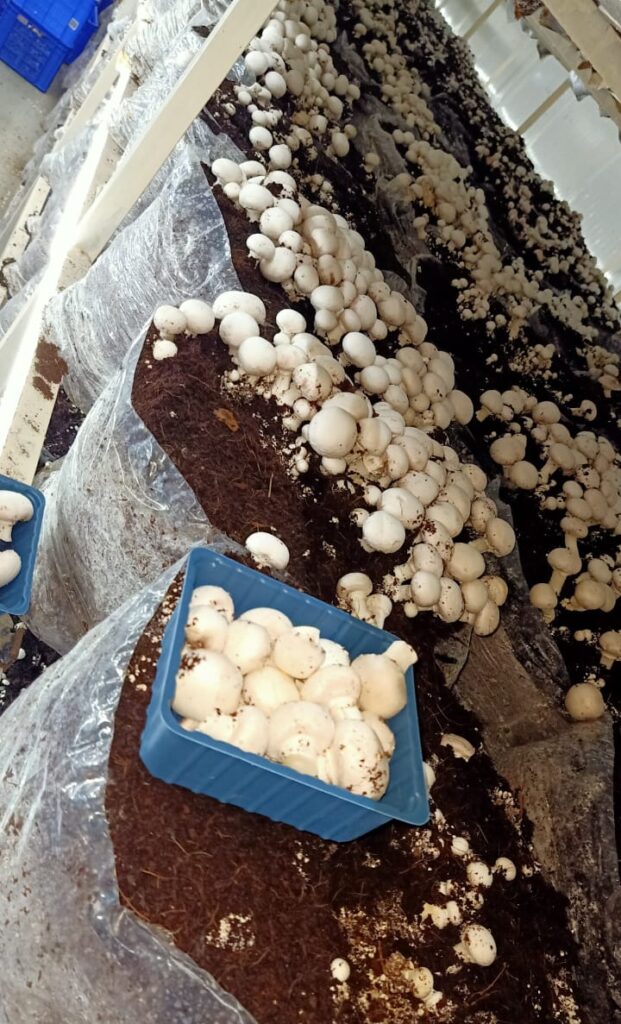About us
We are Nutrifresh Agro . Based in Village – Yari , P.O. & District – Aurangabad (Bihar), Nutrifresh Agro cultivates high-quality White Button mushrooms with innovative techniques to assure that their taste and nutritional value are preserved.
White Button mushrooms have been a staple of the human diet for over 200 years. In recent times, the consumption of White Button mushrooms has seen a steep increase due to their nutritional value and delicious taste.
To meet the growing demand, Nutrifresh Agro brings our consumers a great opportunity to buy high-quality white button mushrooms at wholesale rates.
We have employed a team of hardworking professionals who are trained to meet the exact demands of buyers to ensure complete client satisfaction.

Inside Mushroom Production – How do we do it?
Think about our ancestors who tried and tasted various food items and segregated the medicinal ones from the poisonous. In this pursuit many of them lost their lives and many circumvented to find the food that we can safely eat. Mushrooms come in variety of shapes,colours and sizes. Many of them are poisonous and many of them are beneficial for our health.
White Button Mushrooms are a panacea for many degenerative diseases related to our cardiac, neurological and immune health. As researchers are spending more time researching this fungus, they are discovering more and more health-promoting properties related to it.You canread about the health benefits here
But how do mushroom producers like us serve it to your daily platter? Some of you might think that we cultivate it out of thin air. Well, it’s not so! Lots of steps go into the making of white button
mushroom and today we will discuss them in details.
Phase of Mushroom Production
But how do mushroom producers like us serve it to your daily platter? Some of you might think that we cultivate it out of thin air. Well, it’s not so! Lots of steps go into the making of white button mushroom and today we will discuss them in details.
Step 1
Composting
Though every mushroom-farmer has his own formula which he adjusts according to the geographical, economical and climatic necessities, but Husk straw, Urea and gypsum are common in making the compost.What goes into it is chicken manure that is basically the food for growing the mushrooms.
Composting creates a perfect blend of nutrients that mushrooms can munch on. The Nitrogen cycle
produces enough Nitrogenous nutrients along with carbohydrates and oxygen for mushrooms to proliferate.
Then we add gypsum to reduce the greasiness of the compost which aids to the flocculation of certain essential chemicals. Followed by this we pasteurise the compost with temperature variations that ensure the killing of all germs present in the compost.
Composting creates a perfect blend of nutrients that mushrooms can munch on. The Nitrogen cycle
produces enough Nitrogenous nutrients along with carbohydrates and oxygen for mushrooms to proliferate.
Then we add gypsum to reduce the greasiness of the compost which aids to the flocculation of certain essential chemicals. Followed by this we pasteurise the compost with temperature variations that ensure the killing of all germs present in the compost.
Step 2
Spawning
Mushroom Compost cannot grow mushrooms by itself. It just creates an ecosystem for mushrooms to thrive. Mushroom spawns are like the seeds for mushrooms that are cultivated commercially. These baby mushrooms are inoculated into the compost which starts the process of mushroom colonisation. The colonisation of mushroom in the compost is the fastest at a certain temperature: 75°F. The temperature and high humidity create suitable condition for producing a stringy network. This process is called spawn run. You can read more about Spawning here
Step 3
Casing
Covering the spawn run with a layer of mixture made with clay loam, ground limestone and peat moss is called casing. Casing is important because it creates a water buffer. High water content is important
for the blooming of mushroom which is limited in the compost. Casing holds water without wetting the compost and gives an ideal base. Casing makes mushroom production economical. You can read more about casing here.
Step 4
Pinning
Mushrooms in their earliest form look like pin like structures that peep through the casing. These pins grow and turn into sizeable mushrooms that are ready for harvest.
for the blooming of mushroom which is limited in the compost. Casing holds water without wetting the compost and gives an ideal base. Casing makes mushroom production economical. You can read more about casing here.
Step 5
Pinning
Step 6
Cropping
Cropping or Harvesting is done in 3-days to 5-days cycle when full grown mushrooms are harvested followed by a few days when no mushrooms are cropped. This cycle keeps repeating it until no mushrooms are left.
